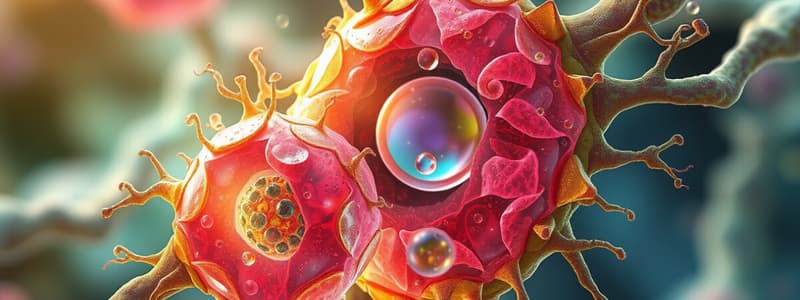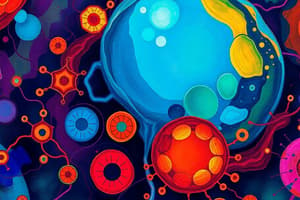Podcast
Questions and Answers
Which statement is true regarding prokaryotic cells?
Which statement is true regarding prokaryotic cells?
- They have a defined nucleus.
- Their DNA is found in the nucleoid. (correct)
- They contain membrane-bound organelles.
- They are generally larger and more complex than eukaryotic cells.
What is the primary function of mitochondria in eukaryotic cells?
What is the primary function of mitochondria in eukaryotic cells?
- Protein synthesis
- Photosynthesis
- Lipid synthesis
- Energy production (correct)
What is the outcome of mitosis?
What is the outcome of mitosis?
- Production of identical daughter cells (correct)
- Creation of diverse cell types
- Formation of gametes
- Reduction of chromosome number by half
During which stage of cellular respiration is glucose broken down into pyruvate?
During which stage of cellular respiration is glucose broken down into pyruvate?
Which organelle is involved in modifying, sorting, and packaging proteins and lipids?
Which organelle is involved in modifying, sorting, and packaging proteins and lipids?
What distinguishes meiosis from mitosis?
What distinguishes meiosis from mitosis?
Which structure regulates transport in and out of the cell?
Which structure regulates transport in and out of the cell?
Which of the following processes converts light energy into chemical energy?
Which of the following processes converts light energy into chemical energy?
What is a characteristic of passive transport?
What is a characteristic of passive transport?
Which mechanisms are involved in active transport?
Which mechanisms are involved in active transport?
How do cells primarily communicate?
How do cells primarily communicate?
What role do cyclins play in the cell cycle?
What role do cyclins play in the cell cycle?
What can result from dysfunction in cell cycle regulation?
What can result from dysfunction in cell cycle regulation?
Flashcards are hidden until you start studying
Study Notes
Cell Biology
1. Cell Theory
- All living organisms are composed of one or more cells.
- The cell is the basic unit of life.
- All cells arise from pre-existing cells.
2. Cell Types
-
Prokaryotic Cells
- No nucleus; DNA is in the nucleoid.
- Lack membrane-bound organelles.
- Typically smaller and simpler (e.g., bacteria).
-
Eukaryotic Cells
- Have a nucleus containing DNA.
- Contain membrane-bound organelles (e.g., mitochondria, endoplasmic reticulum).
- Generally larger and more complex (e.g., plant and animal cells).
3. Cell Structure
-
Cell Membrane
- Phospholipid bilayer that regulates transport in and out of the cell.
-
Nucleus
- Control center containing genetic material (DNA).
-
Cytoplasm
- Jelly-like substance where organelles are suspended.
-
Organelles
- Mitochondria: Energy production (ATP synthesis).
- Ribosomes: Protein synthesis.
- Endoplasmic Reticulum (ER):
- Rough ER: Studded with ribosomes; synthesizes proteins.
- Smooth ER: Lacks ribosomes; synthesizes lipids.
- Golgi Apparatus: Modifies, sorts, and packages proteins and lipids.
- Lysosomes: Digestive organelles that break down waste.
- Chloroplasts (in plant cells): Site of photosynthesis.
4. Cell Division
-
Mitosis
- Process of cell division resulting in two identical daughter cells.
- Stages: Prophase, Metaphase, Anaphase, Telophase, Cytokinesis.
-
Meiosis
- Specialized cell division that reduces chromosome number by half, producing gametes (sperm and egg).
- Involves two rounds of division: Meiosis I and Meiosis II.
5. Cellular Processes
-
Cellular Respiration
- Process of converting glucose and oxygen into ATP, carbon dioxide, and water.
- Stages: Glycolysis, Krebs cycle, Electron transport chain.
-
Photosynthesis
- Process by which plants (and some bacteria) convert light energy into chemical energy (glucose).
- Occurs in chloroplasts; involves light-dependent and light-independent reactions (Calvin cycle).
6. Transport Mechanisms
-
Passive Transport
- Movement of molecules across the cell membrane without energy input (e.g., diffusion, osmosis).
-
Active Transport
- Movement of molecules against their concentration gradient, requiring energy (e.g., sodium-potassium pump).
-
Endocytosis and Exocytosis
- Endocytosis: Process of taking substances into the cell via vesicles.
- Exocytosis: Process of expelling substances from the cell via vesicles.
7. Cell Communication
- Cells communicate through:
- Chemical signals (hormones, neurotransmitters).
- Cell surface receptors that bind to signaling molecules.
- Gap junctions in animal cells allowing direct cytoplasmic transfer.
8. Cell Cycle Regulation
- Regulated by checkpoints to ensure proper division.
- Key proteins include cyclins and cyclin-dependent kinases (CDKs).
- Dysfunction can lead to cancer and other diseases.
Cell Theory
- Living organisms consist of one or more cells.
- The cell serves as the fundamental unit of life.
- All cells originate from already existing cells.
Cell Types
- Prokaryotic Cells
- No true nucleus; genetic material is located in a nucleoid region.
- Absence of membrane-bound organelles, making them simpler and smaller.
- Common examples include bacteria.
- Eukaryotic Cells
- Organized nucleus housing genetic material (DNA).
- Numerous membrane-bound organelles enhance functionality.
- Generally larger and more complex, examples include plant and animal cells.
Cell Structure
- Cell Membrane
- Composed of a phospholipid bilayer, controlling ingress and egress of substances.
- Nucleus
- Acts as the control center, containing cellular genetic material.
- Cytoplasm
- A viscous medium in which organelles are suspended, facilitating biochemical reactions.
- Organelles
- Mitochondria: Central to energy production through ATP synthesis.
- Ribosomes: Sites for protein synthesis, either free-floating or attached to rough ER.
- Endoplasmic Reticulum (ER):
- Rough ER: Ribosome-studded, responsible for protein synthesis.
- Smooth ER: Lacks ribosomes, involved in lipid production.
- Golgi Apparatus: Modifies, sorts, and packages proteins and lipids for transport.
- Lysosomes: Contain digestive enzymes to degrade waste materials.
- Chloroplasts (in plants): Execute photosynthesis, converting light energy into glucose.
Cell Division
- Mitosis
- Involves stages: Prophase, Metaphase, Anaphase, Telophase, and Cytokinesis, yielding two identical daughter cells.
- Meiosis
- Reduces chromosome count by half, producing gametes (sperm and egg).
- Comprises two rounds of division: Meiosis I and Meiosis II.
Cellular Processes
- Cellular Respiration
- Converts glucose and oxygen into ATP, alongside carbon dioxide and water.
- Involves stages: Glycolysis, Krebs cycle, and Electron transport chain.
- Photosynthesis
- Plants and certain bacteria transform light energy into chemical energy.
- Takes place in chloroplasts and includes light-dependent and light-independent reactions (Calvin cycle).
Transport Mechanisms
- Passive Transport
- Involves molecular movement across the membrane without energy use (e.g., diffusion, osmosis).
- Active Transport
- Requires energy to move molecules against their concentration gradient (e.g., sodium-potassium pump).
- Endocytosis and Exocytosis
- Endocytosis: Mechanism for internalizing substances via vesicles.
- Exocytosis: Process for expelling substances from the cell, also utilizing vesicles.
Cell Communication
- Cells utilize chemical signals, including hormones and neurotransmitters, for communication.
- Signaling molecules bind to cell surface receptors, triggering responses.
- Gap junctions in animal cells allow cytoplasmic exchanges between neighboring cells.
Cell Cycle Regulation
- Cell division is overseen by checkpoints to ensure accuracy.
- Cyclins and cyclin-dependent kinases (CDKs) are pivotal regulatory proteins.
- Malfunctioning regulatory systems can contribute to cancer and other diseases.
Studying That Suits You
Use AI to generate personalized quizzes and flashcards to suit your learning preferences.




